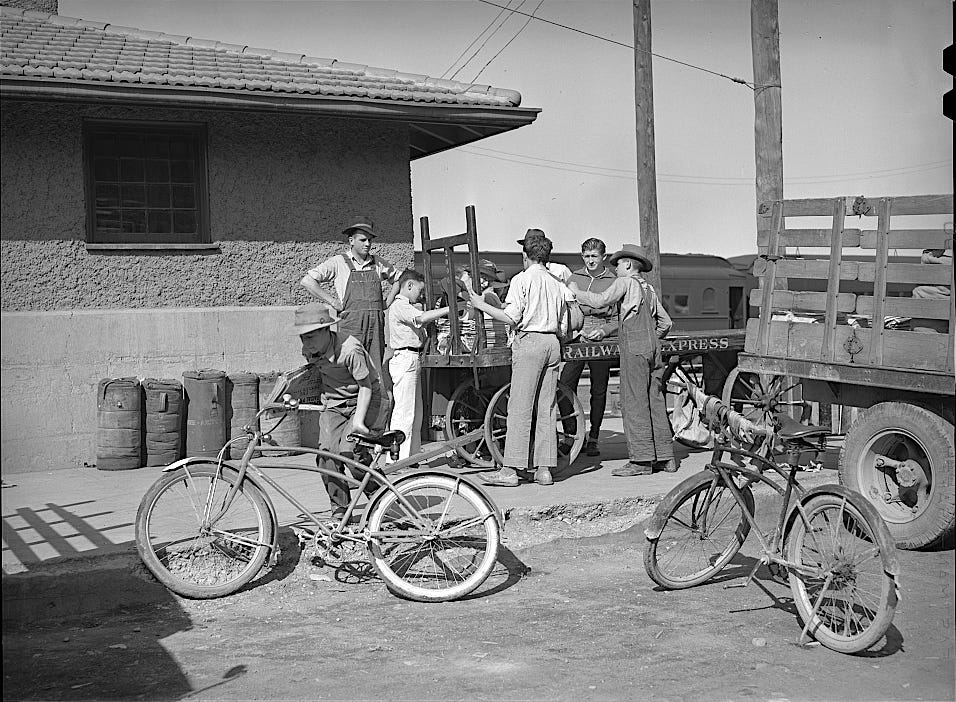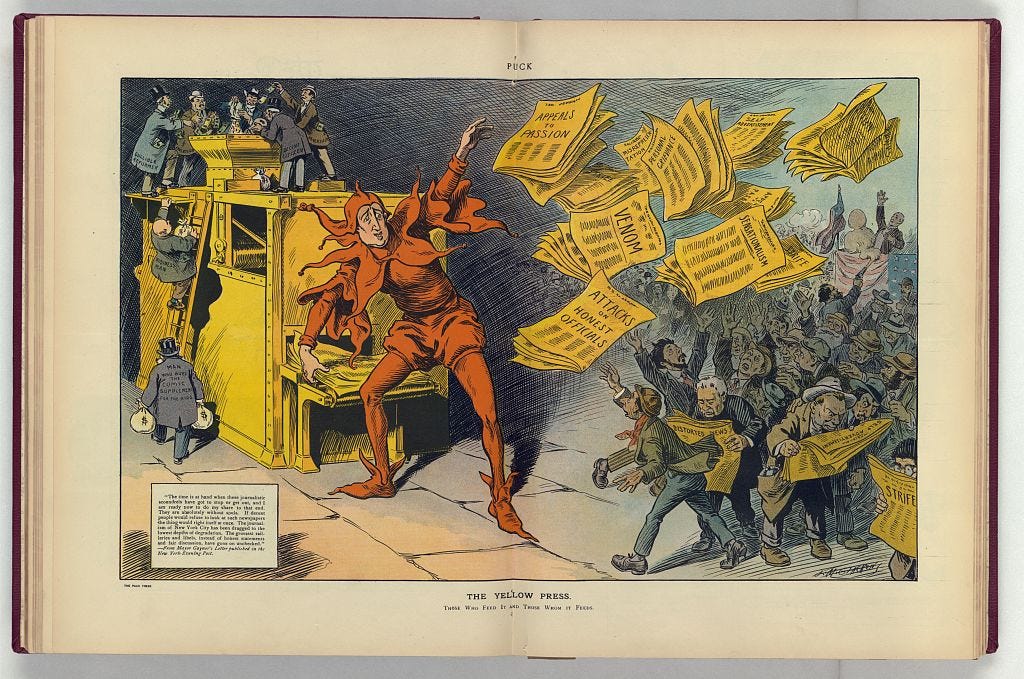Media Lessons from a Tumultuous Week
There are big problems. And a few big solutions. (Once again: think globally, act locally.)

A week different from most other weeks.
Some weeks just float on by. Others are dense with events and potential history. I think the beginning of this month of April has been one of those dense periods.
As a historical comparison: I can remember nearly every week of 1968, when I was a teenager. And nearly every day of that year’s traumatic month of April, starting with the assassination of Martin Luther King Jr.
This past week has not been quite as consequential or traumatic. But for time capsule purposes, let’s note what the start of this April has already brought us:
The first Trump indictment, then the widespread (and overheated) mainstream press forecasts that this would touch off massive protests; then Trump’s grievance-laden speech; then the widespread and probably premature second-guessing of charges filed by Manhattan DA Alvin Bragg. And the reluctance even now of GOP “leaders” to dare criticize Trump.
The revelations of egregious conflicts-of-interest by Clarence Thomas, which would blatantly violate anti-corruption and ethics rules at any level of federal governance except the Supreme Court, which literally has no ethics rules.
The double-digit margin by which voters in Wisconsin voters flipped control of their state’s supreme court away from conservatives—an outcome that, as with the Kansas abortion referendum last summer, “surprised” many of the people whose claimed expertise is telling us how to think about elections.
The egregiously Jim Crow-era move by white Republicans in the Tennessee legislature, when they expelled two of their elected Black colleagues (since reinstated) for joining in a gun protest, but not a white member who had joined the demonstration.
The egregious overreach by one Trump-appointed judge in Texas, who asserted his right to reverse a decades-old FDA decision and outlaw use of Mifepristone across the nation as a whole.
Russia’s egregious decision to jail a credentialed American reporter.
The leaks of U.S. intelligence about Russia, Ukraine, and other countries, whose significance is still being assessed.
Of course the endless gun massacres.
A variety of media developments, notably including increasingly damning evidence against Fox “News” in the Dominion case, and the excellent NYT Magazine piece by Jim Rutenberg about how Fox has made its own problems with Dominion.1
We’ll remember these days. (For family reasons I’ve mostly been away from online life in this period, and am catching up with it all at once). Here are a few leads and press lessons from what we’ve just been through.
1) It’s time for a ‘safety stand-down’ in political coverage.
The aviation world, which I’ve been part of for a long time, recognizes the need for periodic “safety stand-downs.” These are intentional moments of stepping back, suspending business-as-usual, and reflecting on behavior patterns that could lead to dangerous outcomes. I’ve written about the practice frequently, for instance here.
For civic purposes we could use a safety stand-down in political coverage. The media patterns that enabled Donald Trump’s rise eight years ago are appearing again. The aviation world acts with constant awareness of disasters from the past. For the media, it is as if no one had reflected on what went before. For instance:
Spectacle uber alles. In Amusing Ourselves to Death back in the 1980s, Neil Postman wrote about the way pure distraction and spectacle could drown out everything else, if the media allowed it to. Thus we had cable networks showing wall-to-wall Trump rally speeches starting in 2015. After all, they were interesting! Just as the O.J. car chase had been. And now, as if that had never happened, we have wall-to-wall coverage of the Trump arraignment, motorcade and all. Again a car chase, with much higher stakes.
That irrepressible yearning, like the “phantom limb” tingle from an arm or leg that is no longer there, for the lost status of being “objective” and “balanced.” So many people complain about “bias” in so many news organizations. That makes it hard for people outside the business to imagine how much more comfortable people at mainstream news organizations would feel, even now, if they could be seen as just "telling it like it is" and not taking any “side.”2
And thus the instinctive search for comfort and cover by showing “both sides,” even when there’s no intellectual or political equivalence between the two. For instance an article from the NYT after Trump’s first indictment, with this incredible-but-true framing in the headline: “Biden Has the Oval Office. But Trump Has Center Stage.”The impulse to ‘historicize,’ at the cost of historical perspective. It comes naturally to the news business to puff things up to the grandest possible dimensions. You always want to say, “What happened today matters!” even if this day is likely to be skipped over in the history books. After all, that’s why you’re putting the story on the front page. Thus we had this breathless treatment from the NYT just after Trump’s indictment, setting a tone for other news organs:
“A new precedent has been set. Will it tear the country apart, as some feared about putting a former president on trial after Watergate? Will it be seen by many at home and abroad as victor’s justice akin to developing nations where former leaders are imprisoned by their successors?”
Answer: No.
Any more than the instant pronouncements about the U.S. withdrawal from Afghanistan as a “hinge of history” bore up. The “new precedent” for Donald Trump was set long before the Manhattan indictment. As the authors, or certainly the editors, of these pieces realize—and as they could help their readers understand.
Donald Trump and his campaigns may be with us for a while. Every news organization should be having a ‘What did we learn from 2015?’ session right now.
2) We need less ‘political’ reporting and future-casting, and more of everything else.
Reporting on politics has somehow become the prestige pinnacle of newspaper and broadcast journalism. Its practitioners are on TV panels and the book circuit.
I’ve long argued that Americans would be better informed, and simply more interested in the news, and reporters would feel more energized, engaged, and useful, if 90% of today’s political press corps were re-deployed on other beats. And if 90% of the airtime and online emphasis were given to other topics.
-Partly that’s because other topics offer so much more depth and variety. The world is two-dimensional when it comes to presidential politics. The incumbent is doing well, or poorly. The next election will go this way, or it will go like that. Of course this matters, tremendously. But it’s binary.
By comparison stories on other topics — science, business, art, a community’s past and future, interests and achievements, practically anything —are as rich, surprising, and varied as life itself. When you read the presidential-politics stories or sit through the electoral-forecast panels, the world is unsurprising and gray. When you read or learn about anything else, it’s in full color and 3-D.
-And partly it is because the predictions offer such limited guidance. Last week’s margin in the Wisconsin supreme court race was 11 points—a landslide in most contested races. (For comparison: in his runaway victory over Jimmy Carter in 1980, Ronald Reagan’s popular vote margin did not reach ten points.) As with the Democratic strength in last fall’s midterms, the Wisconsin result appeared to catch many “experts” by surprise.
This is not to criticize the experts. It is to question the entire enterprise. Why invest so much time, metaphorical ink, and effort this way?
Let’s do something else.

3) There is something to do about local media.
And this could provide help for media at all levels.
Of two recent TV series based on media empires—Succession on streaming HBO, and Alaska Daily on broadcast ABC—there’s no contest in production values, character development, complexity and subtlety, and so on. I’ll keep watching Succession.
But Alaska Daily, which features Hillary Swank and has just completed its first-season run, is also worth watching. Among the reasons is that it’s built around the possibilities of the “something else” ambitious reporters could do, if they stepped away from limelight-politics and looked into the other 99% of life (and in the case of their series, looking into deaths as well).
Local publications are almost by definition more attuned to the complex realities of economic, civic, and social existence. We also know that current business models are stripping reporters from nearly all of them.
That’s why an excellent new article in Politico, by my longtime friend Steven Waldman, is so refreshing and significant. It explains why “public-private” support for a healthy news ecosystem, including explicit government subsidy for newspapers, magazines, and local media outlets, has been part of U.S policy from the start. And should be again. Some details from his article are below.



